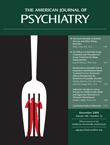Despite the fact that aggression, violence, and impulsive behavior are among the most common and dangerous presenting problems in child and adolescent psychiatry
(1,
2), the psychopharmacology of aggressive, antisocial, and disruptive behaviors is still in its infancy (for complex methodological, clinical, and political reasons)
(3 –
5) . We currently possess a handful of randomized clinical trials (the gold standard in the field), all of relatively brief duration and usually testing single agents in widely diverse groups with a considerable range of psychopathology, yielding moderate effects
(6,
7) . This is the case despite the fact that most experts in the field agree that aggression, especially emotionally hot, impulsive aggression, forms a legitimate target for intervention across a spectrum of psychopathology, including attention deficit hyperactivity disorder (ADHD), bipolar mood disorder, and posttraumatic stress disorder
(5) .
The lack of adequate and clinically useful information is frustrating for clinicians as they deal with these serious problems in youths in schools, clinics, and juvenile justice settings. Very often, the complaint is heard that clinical trials are not as useful as they could be for frontline clinicians. Produced in populations that are “highly select” and carried out in structured social environments, they yield inflated response rates for the agents tested, especially when clinicians try to treat highly comorbid and complex patients. For these frontline providers, polypharmacy is the rule not the exception. Virtually no trials test the effects of adding a second agent after the initial agent has failed.
In this issue of the
Journal, the study by Blader and colleagues
(8) promises to point the way to a more rational, evidence-based polypharmacy, as it addresses the extremely common combination of disruptive behavior and ADHD in a cohort of 6- to 13-year-old children in a double-blind add-on design. A recent meta-analysis of 28 studies
(6) demonstrated that while successful stimulant treatment can be expected to lead to a reduction in overt and covert aggression in children with ADHD across a range of ages and using different agents, effect sizes vary widely, leaving open the question of what to do with the considerable number of nonresponders.
The study conducted by Blader and colleagues is one of the few systematic and well-controlled psychopharmacological trials among children and adolescents for adjunctive therapy. Participants were treated in a lead-in phase with an open trial of a range of sustained-release stimulant preparations. If stabilization of aggressive behavior was not achieved after this period of optimization, then subjects were randomly assigned to a double-blind, placebo-controlled trial of divalproex. The trial ended 8 weeks after randomization, allowing sufficient time for response to develop.
In the intent-to-treat analyses and mixed-effects regression analyses of aggression over time, it was shown that over 58% of children receiving divalproex remitted, versus 15% receiving placebo. The regression analyses showed steeper and significant decline by week in the divalproex condition. Both treatment conditions were well tolerated. These results are comparable with those achieved in our older cohort of male adolescents with conduct disorders who were treated with divalproex as a single agent
(9) .
The high rates of retention in the study in all phases were encouraging and most likely a result of the wise decision to offer a psychosocial intervention package to the participants that targeted parents
(10) . The results offer a more realistic picture of aggression in the context of ADHD and a better roadmap of future directions when dealing with these complex patients. When the most effective treatment for ADHD fails in producing outcomes in one of the most troublesome comorbid conditions, adding a second psychopharmacological agent with an entirely different efficacy profile can produce desired results in a substantial number of patients.
The study clearly has limitations: the sample size is relatively small; there are very few girls; the age range is restricted; and the duration of the trial is brief. Nevertheless, there were strong signals emerging from the data to allow conclusions. One area of particular caution, though, should be the consideration of gender effects. It cannot be safely assumed that the reported effects would readily be duplicated in girls.
The future of psychopharmacology in childhood aggression and its underlying disorders is an important area of great need for more work along the lines demonstrated in this study. It is unrealistic to assume, as we have been for some time, that complex behaviors, such as aggression
(3), will respond robustly to single psychopharmacological agents in all patients and all types of comorbidity, and yet the bulk of clinical trials are done with single agents. A more realistic assumption is that a careful blend of activating (like stimulants) and inhibiting (arguably valproic acid) agents will ultimately result in controls of main and downstream effects of neurotransmitters that produce remission of symptoms. This is especially likely in children and adolescents in whom development generates rapid shifts in neurosystems underpinning instrumental behavior such as aggression.
This study points the way to a more complicated, but ultimately more realistic, polypharmacology in developmental psychiatry that should produce better results for our patients, rather than some of the unfortunate “polypsychopharmacology,” where a high number of agents is combined in suboptimal doses in hopes of producing desired results. Such practices, spawned in the hope of helping our most troubled children and families, will undoubtedly be improved as research, such as that conducted by Blader and colleagues, provides the more robust underpinnings of our clinical practices addressing complex psychiatric symptoms.

